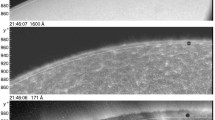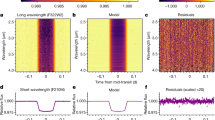Abstract
This paper presents the results of a study with images of the Mercury transit of the Sun, 15 November 1999, as observed at the Prairie View Solar Observatory and with three wavelengths of the TRACE satellite. These CCD observations provide an objective source for comparing the optical effects that cause the historic Black Drop under different conditions and with different filters. It appears that a sharp, uniform boundary of sufficient contrast (the solar limb, with the sky beyond the limb being at least as dark as the interior of the Mercurian disk), with a blurring agent, is necessary to produce the effect. Without all these conditions, as in the case of narrow-band Hα at line center or the TRACE UV (1600 Å) and EUV (171 Å), the visibility of the Black Drop is greatly reduced or eliminated, due to the contrast-lowering background of the chromosphere or corona, scattering more light into the umbilicus region.
Similar content being viewed by others
References
Brahde, R.: 1972, Solar Phys. 26, 318.
Cowell, P. H.: 1905, Monthly Notices Royal Astron. Soc. 66, 36C.
Croce, V.: 1973, Icarus 20, 190.
Hyder, C. L.: 1969, Solar Phys. 6, 482.
Macdonald, P.: 1991, J. Br. Astron. Assoc. 101, 3.
Maltby, P.: 1971, Solar Phys. 18, 3.
Maor, E.: 2000, June 8, 2004-Venus in Transit, Princeton University Press.
Martinez Pillet, M., Ruiz Cobo, B., and Vazquez, M.: 1990, Solar Phys. 125, 211.
Mattig, W.: 1971, Solar Phys. 18, 434.
Morrison, L. V. and Ward, C. G.: 1975, Monthly Notices Royal Astron. Soc. 173, 183.
Schneider, G., Pasachoff, J. M., and Golub, L.: 2001, Div. of Planetary Sciences meeting, November 2001 [10.02].
Wittmann, A.: 1974, Astron. Astrophys. 31, 239.
Wittmann, A. and Wöhl, H.: 1975, Solar Phys. 44, 231.
Wülser, J. P., Hudson, H. S., Nishio, M., Kosugi, T., Masuda, S., and Morrison, M.: 1998, Solar Phys. 180, 131.
Author information
Authors and Affiliations
Rights and permissions
About this article
Cite this article
Cudnik, B. Multi-Wavelength CCD Observations of the 15 November 1999 Mercury Transit. Solar Physics 219, 197–216 (2004). https://doi.org/10.1023/B:SOLA.0000022972.82632.4c
Issue Date:
DOI: https://doi.org/10.1023/B:SOLA.0000022972.82632.4c




